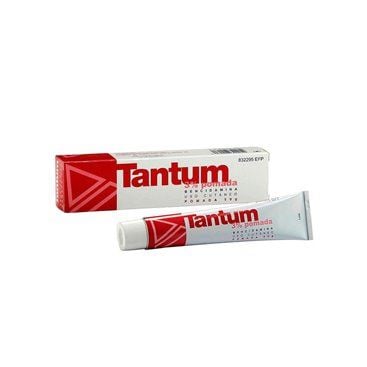Tantum 30mg/g Ointment 50G
Tantum contains the active ingredient benzydamine hydrochloride, which belongs to the group of non-steroidal anti-inflammatory drugs. It is used for local symptomatic relief of muscle and joint pain caused by: bruises, blows, sprains, strains, contractures, sprains and lumbago, in adults and adolescents over 12 years of age.
Tantum contains the active ingredient benzydamine hydrochloride, which belongs to the group of non-steroidal anti-inflammatory drugs. It is used for local symptomatic relief of muscle and joint pain caused by: bruises, blows, sprains, strains, contractures, sprains and lumbago, in adults and adolescents over 12 years of age.
Tantum (30 Mg/G Ointment 1 Tube 50 G)
Benzydamine hydrochloride 30Mg
ACTION AND MECHANISM
Benzydamine is a non-steroidal [ANTI-INFLAMMATORY] and [ANALGESIC], which acts by preventing the synthesis of prostaglandins and other prostanoids, by inhibiting cyclooxygenase, which is involved in inflammatory processes.
PHARMACOKINETICS
- Absorption: After skin application, benzydamine is absorbed through the skin, reaching pharmacologically active concentrations in the subcutaneous tissues near the area of application. The mean bioavailability, relative to oral administration, is less than 10%.
- Distribution: The levels reached in plasma are low, lower than those reached by oral administration, with which the systemic adverse effects are limited. The maximum levels observed in plasma are reached after 30 hours of topical application, which indicates its persistence in the deep layers of the skin.
- Elimination: It is produced by urine, and a small proportion by bile, in unchanged form or by inactive metabolites.
INDICATIONS
- Local symptomatic relief of painful or inflammatory conditions, of traumatic or degenerative origin of the joints, tendons, ligaments and muscles ([ARTHRITIS], periarthritis, [CAPSULITIS], arthrosynovitis, [TENOSYNOVITIS], [BURSITIS], distortions, meniscal injuries of the knee, [MUSCULAR CONTRACTURE][TENDINITIS], [CONTUSION], [SPRAIN], [LUMBALGIA], [TORTICOLIS], [LUXATION]).
POSOLOGY
DOSAGE:
- Exclusively external skin use.
- Adults and children over 12 years: apply 3 to 4 times a day.
- Do not apply more than 7 days in a row without consulting a doctor.
RULES FOR CORRECT ADMINISTRATION
- Apply a thin layer of the product to the affected area with a light massage to facilitate penetration.
- Wash hands after each application.
- Do not apply occlusive dressings.
CONTRAINDICATIONS
- Hypersensitivity to benzydamine or any of the components of this medicine.
- [ALLERGY TO NSAIDs], [ALLERGY TO SALICYLATES]: Although local administration minimizes the risks derived from its systemic use, topical application, in large areas of the skin, in open wounds, mucosa or eczematous skin, prolonged and with the use of occlusive dressings, it can cause systemic effects, so it should be remembered that its use is not recommended in patients who have presented allergic reactions (rhinitis, asthma, pruritus, angioedema, hives, shock or others), caused by acid aspirin or other NSAIDs due to the possibility of cross-hypersensitivity.
ADVICE TO THE PATIENT
- Avoid contact with eyes and mucous membranes.
- Do not use with occlusive dressings or apply simultaneously in the same area as other topical preparations.
- Do not use for prolonged periods of time or in large areas.
- Use only on intact skin, not on open wounds, mucous membranes or eczematous skin.
- Do not expose the treated area to the sun.
- Wash hands after each application.
SPECIAL WARNINGS
- If symptoms persist for more than 7 days or irritation or worsening occurs, the patient's clinical condition should be evaluated.
- Sun exposure of the treated area can cause photosensitivity.
INTERACTIONS
They have not been described in cutaneous use, since very low systemic concentrations of the drug are reached, but it will be assessed whether it should be used together with other topical analgesics.
PREGNANCY
Although systemic absorption is very small due to cutaneous use, the preparation should not be used during pregnancy except for medical criteria, since NSAIDs, especially during the third trimester, can cause dystocia, delay delivery and cause adverse effects on the fetal cardiovascular system. , such as premature closure of the ductus arteriosus.
LACTATION
Although systemic absorption is very small due to cutaneous use, the preparation should not be used during lactation except for medical criteria.
ADVERSE REACTIONS
- Moderate local [ERITEMA] (0.1%-1%), [DERMATITIS], [SKIN IRRITATION], [PRURITO] (0.1%-1%) and sensation of [SKIN IRRITATION] may occur in the skin area. application, which disappear when the treatment is stopped.
- [PHOTOSENSITIVITY REACTIONS] may appear (0.01%-0.1%)
- In the event that symptoms appear for which no justification is found, the treatment must be suspended and the patient's clinical situation will be reassessed.
- Prolonged topical administration, in large areas of skin, on open wounds, mucous membranes or eczematous skin, as well as the use of occlusive dressings, can cause the appearance of systemic adverse reactions typical of NSAIDs.
OVERDOSE
- Symptoms: Due to its external use, it is unlikely that poisoning will occur.
In case of accidental ingestion, the symptoms of overdose will be systemic adverse reactions that will depend on the dose ingested and the time elapsed since ingestion.
- Treatment: if accidental ingestion occurs, gastric lavage and symptomatic therapy will be performed.




